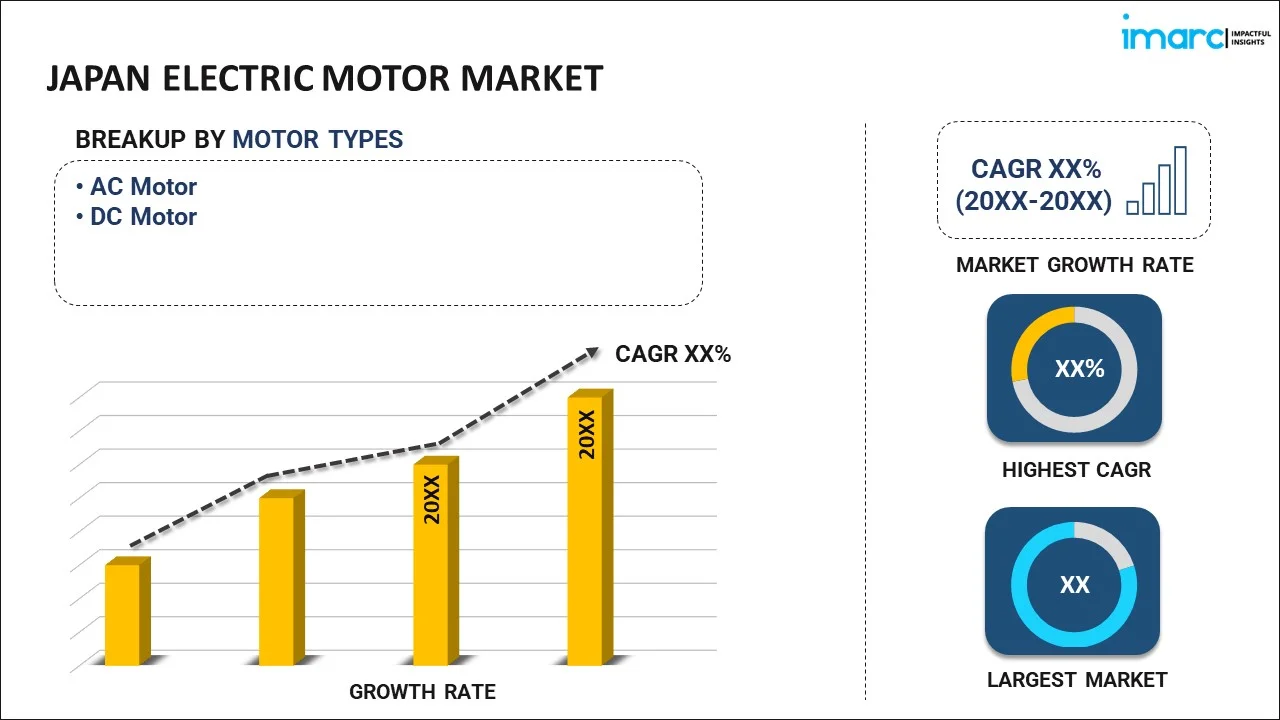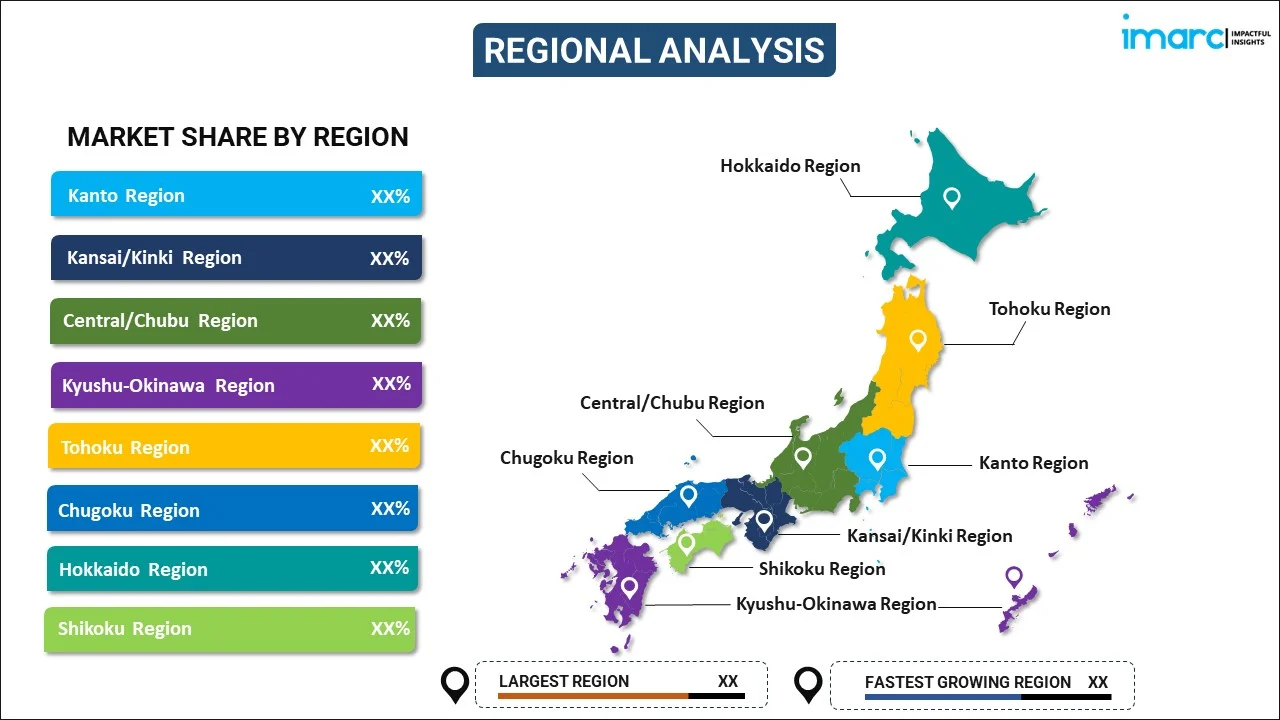
Japan Electric Motor Market Report by Motor Type (AC Motor, DC Motor), Voltage (Low Voltage Electric Motors, Medium Voltage Electric Motors, High Voltage Electric Motors), Rated Power (Fractional Horsepower Motors, Integral Horsepower Motors), Magnet Type (Ferrite, Neodymium (NdFeB), Samarium Cobalt (SmCo5 and Sm2Co17)), Weight (Low Weight Motors, Medium Weight Motors, High Weight Motors), Speed (Ultra-High-Speed Motors, High-Speed Motors, Medium Speed Motors, Low Speed Motors), Application (Industrial Machinery, HVAC, Transportation, Household Appliances, Motor Vehicles, Aerospace, Marine, Robotics, and Others), and Region 2025-2033
Market Overview:
Japan electric motor market size reached USD 8.0 Million in 2024. Looking forward, IMARC Group expects the market to reach USD 43.6 Million by 2033, exhibiting a growth rate (CAGR) of 20.7% during 2025-2033. The market is being driven by a growing focus on energy conservation, supportive government policies, the emergence of electric vehicles, the growing inclination towards industrial automation, notable advancements in technology, and cost-effective solutions.
|
Report Attribute
|
Key Statistics
|
|---|---|
|
Base Year
|
2024 |
|
Forecast Years
|
2025-2033 |
|
Historical Years
|
2019-2024
|
| Market Size in 2024 | USD 8.0 Million |
| Market Forecast in 2033 | USD 43.6 Million |
| Market Growth Rate (2025-2033) | 20.7% |
An electric motor transforms electrical energy into mechanical energy, facilitating the movement derived from electrical power. This transformation relies on the principles of electromagnetism, where the interplay between electric currents and magnetic fields produces a mechanical force. Essential components of an electric motor encompass the stator and rotor. The stator, a fixed segment, typically contains coils that, when energized by electricity, generate a magnetic field. In contrast, the rotor, which is the moving part, usually features permanent magnets or electromagnets. As electric current courses through the stator coils, a magnetic field emerges. This field then engages with the rotor's magnetic field, prompting the rotor to rotate.
Japan Electric Motor Market Trends:
The electric motor market in Japan has consistently been at the forefront of innovation and growth, echoing the nation's rich technological legacy and its commitment to sustainable energy solutions. Rooted in Japan's meticulous manufacturing traditions, electric motors produced here are renowned globally for their efficiency, reliability, and advanced engineering. The nation's rapid urbanization, coupled with its vision of a sustainable future, has spurred demand for energy-efficient appliances and electric vehicles, both of which rely heavily on electric motors. Furthermore, the Japanese government's proactive stance on reducing carbon footprints has ushered in supportive policies, incentivizing industries to adopt energy-efficient systems. This has further amplified the deployment of electric motors in various sectors, ranging from transportation to industrial automation. Another pivotal factor fueling the market's growth is Japan's increasing focus on electric vehicles (EVs), given the shift towards cleaner transportation solutions. With leading automakers headquartered in Japan, the demand for high-performance electric motors for EVs has seen a significant surge. In essence, the electric motor market in Japan thrives on a blend of cutting-edge technology, supportive governmental policies, and the nation's overarching aim for an eco-friendly, energy-efficient future.
Japan Electric Motor Market Segmentation:
IMARC Group provides an analysis of the key trends in each segment of the market, along with forecasts at the country level for 2025-2033. Our report has categorized the market based on motor type, voltage, rated power, magnet type, weight, speed, and application.
Motor Type Insights:

- AC Motor
- Induction AC Motor
- Synchronous AC Motor
- DC Motor
- Brushed DC Motor
- Brushless DC Motor
The report has provided a detailed breakup and analysis of the market based on the motor type. This includes AC motor (induction AC motor and synchronous AC motor), and DC motor (brushed DC motor and brushless DC motor).
Voltage Insights:
- Low Voltage Electric Motors
- Medium Voltage Electric Motors
- High Voltage Electric Motors
A detailed breakup and analysis of the market based on the voltage have also been provided in the report. This low voltage electric motors, medium voltage electric motors, and high voltage electric motors.
Rated Power Insights:
- Fractional Horsepower Motors
- Fractional Horsepower (< 1/8) Motors
- Fractional Horsepower (1/8 - 1/2) Motors
- Fractional Horsepower (1/2 - 1) Motors
- Integral Horsepower Motors
- Integral Horsepower (1 - 5) Motors
- Integral Horsepower (10 - 50) Motors
- Integral Horsepower (50 - 100) Motors
- Integral Horsepower (>100) Motors
The report has provided a detailed breakup and analysis of the market based on the rated power. This includes fractional horsepower motors (fractional horsepower (< 1/8) motors, fractional horsepower (1/8 - 1/2) motors, and fractional horsepower (1/2 - 1) motors) and integral horsepower motors (integral horsepower (1 - 5) motors, integral horsepower (10 - 50) motors, integral horsepower (50 - 100) motors, and integral horsepower (>100) motors).
Magnet Type Insights:
- Ferrite
- Neodymium (NdFeB)
- Samarium Cobalt (SmCo5 and Sm2Co17)
A detailed breakup and analysis of the market based on the magnet type have also been provided in the report. This includes ferrite, neodymium (NdFeB), and samarium cobalt (SmCo5 and Sm2Co17).
Weight Insights:
- Low Weight Motors
- Medium Weight Motors
- High Weight Motors
The report has provided a detailed breakup and analysis of the market based on the weight. This includes low weight motors, medium weight motors, and high weight motors.
Speed Insights:
- Ultra-High-Speed Motors
- High-Speed Motors
- Medium Speed Motors
- Low Speed Motors
A detailed breakup and analysis of the market based on the speed have also been provided in the report. This includes ultra-high-speed motors, high-speed motors, medium speed motors, and low speed motors.
Application Insights:
- Industrial Machinery
- HVAC
- Transportation
- Household Appliances
- Motor Vehicles
- Aerospace
- Marine
- Robotics
- Others
The report has provided a detailed breakup and analysis of the market based on the application. This includes industrial machinery, HVAC, transportation, household appliances, motor vehicles, aerospace, marine, robotics, and others.
Regional Insights:

- Kanto Region
- Kansai/Kinki Region
- Central/ Chubu Region
- Kyushu-Okinawa Region
- Tohoku Region
- Chugoku Region
- Hokkaido Region
- Shikoku Region
The report has also provided a comprehensive analysis of all the major regional markets, which include Kanto Region, Kansai/Kinki Region, Central/ Chubu Region, Kyushu-Okinawa Region, Tohoku Region, Chugoku Region, Hokkaido Region, and Shikoku Region.
Competitive Landscape:
The market research report has also provided a comprehensive analysis of the competitive landscape. Competitive analysis such as market structure, key player positioning, top winning strategies, competitive dashboard, and company evaluation quadrant has been covered in the report. Also, detailed profiles of all major companies have been provided.
Japan Electric Motor Market Report Coverage:
| Report Features | Details |
|---|---|
| Base Year of the Analysis | 2024 |
| Historical Period | 2019-2024 |
| Forecast Period | 2025-2033 |
| Units | Million USD |
| Scope of the Report | Exploration of Historical and Forecast Trends, Industry Catalysts and Challenges, Segment-Wise Historical and Predictive Market Assessment:
|
| Motor Types Covered |
|
| Voltages Covered | Low Voltage Electric Motors, Medium Voltage Electric Motors, High Voltage Electric Motors |
| Rated Powers Covered |
|
| Magnet Types Covered | Ferrite, Neodymium (NdFeB), Samarium Cobalt (SmCo5 and Sm2Co17) |
| Weights Covered | Low Weight Motors, Medium Weight Motors, High Weight Motors |
| Speeds Covered | Ultra-High-Speed Motors, High-Speed Motors, Medium Speed Motors, Low Speed Motors |
| Applications Covered | Industrial Machinery, HVAC, Transportation, Household Appliances, Motor Vehicles, Aerospace, Marine, Robotics, Others |
| Regions Covered | Kanto Region, Kansai/Kinki Region, Central/ Chubu Region, Kyushu-Okinawa Region, Tohoku Region, Chugoku Region, Hokkaido Region, Shikoku Region |
| Customization Scope | 10% Free Customization |
| Post-Sale Analyst Support | 10-12 Weeks |
| Delivery Format | PDF and Excel through Email (We can also provide the editable version of the report in PPT/Word format on special request) |
Key Questions Answered in This Report:
- How has the Japan electric motor market performed so far and how will it perform in the coming years?
- What has been the impact of COVID-19 on the Japan electric motor market?
- What is the breakup of the Japan electric motor market on the basis of motor type?
- What is the breakup of the Japan electric motor market on the basis of voltage?
- What is the breakup of the Japan electric motor market on the basis of rated power?
- What is the breakup of the Japan electric motor market on the basis of magnet type?
- What is the breakup of the Japan electric motor market on the basis of weight?
- What is the breakup of the Japan electric motor market on the basis of speed?
- What is the breakup of the Japan electric motor market on the basis of application?
- What are the various stages in the value chain of the Japan electric motor market?
- What are the key driving factors and challenges in the Japan electric motor?
- What is the structure of the Japan electric motor market and who are the key players?
- What is the degree of competition in the Japan electric motor market?
Key Benefits for Stakeholders:
- IMARC’s industry report offers a comprehensive quantitative analysis of various market segments, historical and current market trends, market forecasts, and dynamics of the Japan electric motor market from 2019-2033.
- The research report provides the latest information on the market drivers, challenges, and opportunities in the Japan electric motor market.
- Porter's five forces analysis assist stakeholders in assessing the impact of new entrants, competitive rivalry, supplier power, buyer power, and the threat of substitution. It helps stakeholders to analyze the level of competition within the Japan electric motor industry and its attractiveness.
- Competitive landscape allows stakeholders to understand their competitive environment and provides an insight into the current positions of key players in the market.
Need more help?
- Speak to our experienced analysts for insights on the current market scenarios.
- Include additional segments and countries to customize the report as per your requirement.
- Gain an unparalleled competitive advantage in your domain by understanding how to utilize the report and positively impacting your operations and revenue.
- For further assistance, please connect with our analysts.
 Inquire Before Buying
Inquire Before Buying
 Speak to an Analyst
Speak to an Analyst
 Request Brochure
Request Brochure
 Request Customization
Request Customization




.webp)




.webp)












